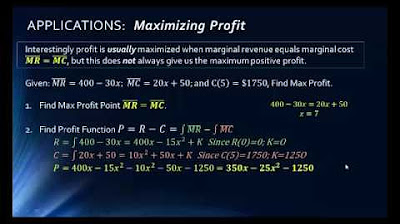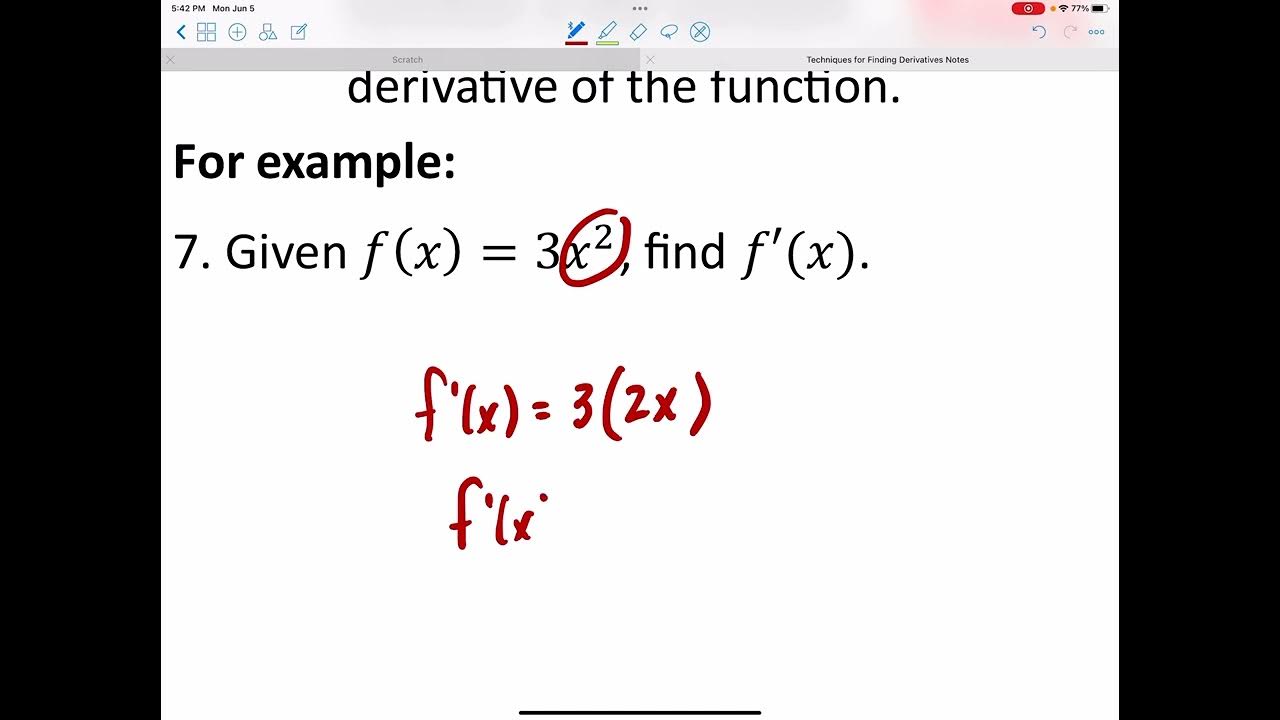Fundamentals of Marx: Falling Profit Rates (LTRPF)
TLDRThis video explores the law of the tendency of the rate of profit to fall, a concept introduced by Marx but also acknowledged by economists like Adam Smith and David Ricardo. The script uses an example of a TV company to illustrate how increased automation can lead to lower production costs and higher profits, but also a shift in the ratio between constant and variable capital, potentially reducing the rate of profit. It discusses how capitalists might counteract this tendency and highlights the inherent contradictions within capitalism that drive the rate of profit down while simultaneously seeking higher profits.
Takeaways
- 📚 The video discusses the 'Law of the Tendency of the Rate of Profit to Fall', a concept introduced by Karl Marx but also acknowledged by liberal economists like Adam Smith and David Ricardo.
- 🏭 Marx's law suggests that the rate of profit tends to fall over time due to increased automation and the substitution of labor with machinery, which reduces the amount of surplus value that can be generated.
- 🛠️ An example is given where a company named Phony introduces an assembly machine that cuts the production time for a TV by 50%, allowing it to produce more TVs at a lower cost and sell them at competitive prices.
- 💡 The innovation by Phony leads to a temporary advantage and windfall profits, which can be used in various ways by the company's leadership, but the societal consequences are of primary interest.
- 🔄 The shift to machinery increases the ratio of constant capital (means of production) to variable capital (labor power), which can lead to a decrease in the rate of profit as less labor power is used to create new value.
- 💰 Capitalists can counteract the falling rate of profit by changing the rate of exploitation, which is the ratio of paid to unpaid labor, by extending working hours or increasing productivity.
- 🔄 Marx's laws describe general tendencies and do not account for all behaviors or manifestations of capital, acknowledging the presence of counter-tendencies and the dynamic interaction between patterns.
- 🔮 The logical end stage of the tendency is an automated economy where commodities are produced at no variable cost, and no new value is created, challenging the profitability of capitalist enterprises.
- 🤔 The Law of the Tendency of the Rate of Profit to Fall is controversial, with empirical and theoretical critiques, including Okishio's theorem which challenged the law by showing that investment in constant capital did not necessarily result in a profit drop.
- 📈 The Temporal Single System Interpretation (TSSI) of Marx's value theory was a response to Okishio's theorem, arguing that the rate of profit should be measured based on the money actually invested in production rather than replacement costs.
- 📚 The video concludes by encouraging viewers to explore the extensive academic debates and literature on the law for a deeper understanding and its application to modern conditions.
Q & A
What is the law of the tendency of the rate of profit to fall?
-The law of the tendency of the rate of profit to fall is a concept in Marxist economics that suggests there is a long-term trend for the rate of profit in a capitalist economy to decline due to increasing productivity and the consequent reduction in the relative input of labor power in the production process.
Who were the liberal economists that preceded Marx in discussing the tendency for the rate of profit to fall?
-Adam Smith and David Ricardo were liberal economists who discussed the tendency for the rate of profit to fall before Marx.
What is the significance of the example of the TV company called Phony in the script?
-The example of Phony is used to illustrate how a company can gain a competitive advantage through technological innovation, reducing the socially necessary labor-time and thus being able to sell products at a lower price, attracting consumers and forcing competitors to adapt or fall behind.
What is the difference between constant capital and variable capital in the context of this script?
-Constant capital represents the part of the production process made up of the means of production, such as machinery and technology. Variable capital represents the workers' input of their labor power, which is essential for creating new value and surplus value in the commodities produced.
How does the introduction of an assembly machine by Phony affect the rate of profit?
-The introduction of the assembly machine by Phony reduces the time it takes to produce a TV, increasing the output and allowing Phony to sell TVs at a lower price. This innovation leads to a temporary advantage and potentially higher profits, but it also shifts the ratio between constant and variable capital, which can affect the rate of profit in the long run.
What is the rate of exploitation and how is it calculated?
-The rate of exploitation is the ratio between paid and unpaid labor of the worker. It is calculated by dividing the amount of labor time for which the worker is paid (paid labor) by the total labor time, including the time worked beyond the paid labor to create surplus value for the capitalist (unpaid labor).
How can capitalists combat the falling rate of profit according to the script?
-Capitalists can combat the falling rate of profit by changing the rate of exploitation, which involves altering the balance between the paid and unpaid labor time of the workers, or by making decisions that increase productivity and reduce costs.
What is the logical end stage of the tendency of the rate of profit to fall, as described in the script?
-The logical end stage of this tendency is an economy where everything is automated, including the production of machines. In such a scenario, commodities would be produced at no variable cost, and since no new value would be created by human labor, capitalist enterprises would have no means to acquire profit from the production process.
What are some of the counter tendencies that Marx acknowledged in his theory?
-Marx acknowledged that there are counter tendencies that can offset the falling rate of profit. These include decisions made by capitalists and systemic factors that can influence the dynamics of the capitalist economy and its profit rates.
What is the Temporal Single System Interpretation (TSSI) of Marx's value theory, and how does it respond to Okishio's theorem?
-The Temporal Single System Interpretation (TSSI) is a response to Okishio's theorem, which challenged Marx's law by showing that increasing investment in constant capital did not result in a drop in the rate of profit. TSSI scholars argue that Marx's understanding of the rate of profit was based on profit as a percentage of the actual money invested in production, rather than the replacement cost used by Okishio.
What are some of the empirical and theoretical critiques of the law of the tendency of the rate of profit to fall?
-Some of the critiques include Okishio's theorem, which empirically demonstrated that increasing investment in constant capital did not necessarily lead to a fall in the rate of profit. Theoretically, there are debates about the interpretation of Marx's value theory and the applicability of the law in modern economic conditions.
Outlines
📉 The Law of the Tendency of the Rate of Profit to Fall
This paragraph introduces the concept of the law of the tendency of the rate of profit to fall, a principle discussed by Marx and his predecessors like Adam Smith and David Ricardo. It explains the law through an example involving a TV company, 'Phony', which increases its production efficiency through automation, thereby reducing the cost of production and selling TVs at a lower price. This attracts consumers and forces competitors to adopt similar technologies, leading to a shift in the standard production time and a change in the ratio between constant and variable capital. The paragraph emphasizes the impact of technological innovation on the surplus value and the rate of profit, and how capitalists might counteract the falling rate of profit by changing the rate of exploitation.
🤝 Capitalism, Competition, and the Rate of Profit Debate
The second paragraph delves into the controversy surrounding the law of the tendency of the rate of profit to fall (LTR PF). It discusses how competition within capitalism can paradoxically drive down the rate of profit as capitalists seek higher profits. The paragraph also addresses empirical criticisms of the law, particularly the work of Japanese Marxist economist Toki Co, who argued that increased investment in constant capital did not lead to a decrease in the rate of profit. The Temporal Single System Interpretation (TSS I) of Marx's value theory is presented as a counterargument to Co's theorem, suggesting that Co's methodology led to an inaccurate conclusion about the relationship between investment in constant capital and the rate of profit over time. The paragraph concludes by acknowledging the ongoing academic debates and inviting further exploration of the topic.
Mindmap
Keywords
💡Law of the Tendency of the Rate of Profit to Fall
💡Marx
💡Socially Necessary Labour-Time
💡Constant Capital
💡Variable Capital
💡Surplus Value
💡Rate of Exploitation
💡Counter Tendencies
💡Automation
💡Competition
💡Empirical Critiques
Highlights
Introduction to the law of the tendency of the rate of profit to fall, a concept explored by Marx and acknowledged to have predecessors like Adam Smith and David Ricardo.
Explanation of the law using an example of a TV company called Phony, which increases production efficiency with an assembly machine.
Phony's innovation leads to a temporary advantage and windfall profits due to lower production costs and market competition.
The societal consequences of Phony's innovation, including the shift in the ratio between constant and variable capital in production.
The concept of surplus value and its importance to capitalist enterprises as the basis for profit.
The impact of technological advancements on the rate of profit, with a decrease in surplus value due to increased productivity.
Capitalists' strategies to combat the falling rate of profit, such as changing the rate of exploitation.
The equation representing the rate of exploitation and its components: paid and unpaid labor.
Marxian laws as general tendencies that do not account for all behaviors of capital.
The presence of counter tendencies and their interaction with general patterns over time.
The tendency for profits to equalize between competing capitals and the challenges posed by differentiated rates of profit.
The logical end stage of the tendency where automation leads to commodities being produced at no variable cost.
The contradiction in capitalism where competition drives the rate of profit down, despite the pursuit of higher profits.
The controversy surrounding the Law of the Tendency of the Rate of Profit (LTR PF) and its critiques.
The empirical critique by Japanese Marxist economist Toki Co and the response by the Temporal Single System Interpretation (TSS I).
The ongoing academic debates and the availability of extensive literature for further understanding of the law.
Conclusion of the video with an invitation for viewers to share their thoughts in the comment section.
Transcripts
5.0 / 5 (0 votes)
Thanks for rating:





